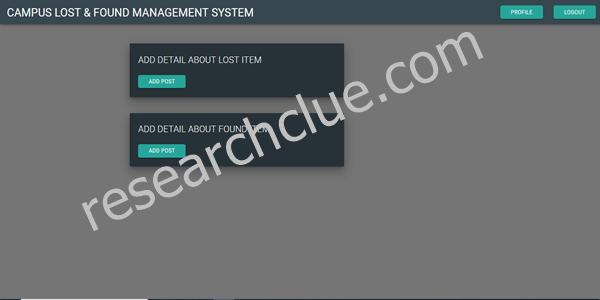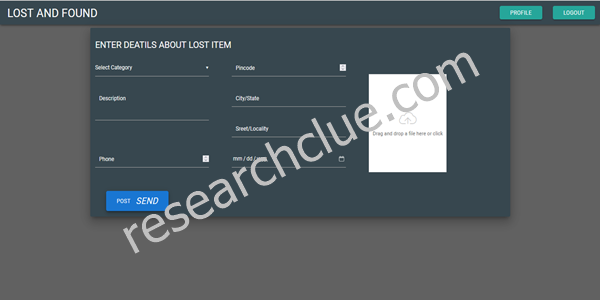ABSTRACT
The paper examines Automated Campus lost and found management system (a case study of University of Uyo). Considering the numerous challenges campuses face in connecting with students and lecturers who lose their valuables on campuses, the paper aims at developing a secure and convenient management system where students and lecturers can login to find their missing properties found by others on campus in real time. Considering technology used in implementing this work, the researcher used HTML, CSS, SQL and PHP. These technologies were considered because of its robust and simplicity in solving complex issues faced by many campuses in Nigeria.
CHAPTER ONE
INTRODUCTION
1.1 Background to the Study
Lost and found management is a crucial aspect of campus operations, ensuring the safe return of lost items to their rightful owners while maintaining efficient administrative processes. Traditional methods of managing lost and found items often involve manual record-keeping and cumbersome retrieval procedures, leading to inefficiencies and delays in item recovery. In response to these challenges, the development of an automated campus lost and found management system has gained traction, aiming to streamline the process through digitalization and integration of modern technologies. This paper introduces the concept of such a system, highlighting its significance in enhancing campus security, customer service, and operational efficiency.
The proposed automated campus lost and found management system leverages advanced technologies such as barcode scanning, database management, and mobile applications to facilitate seamless item registration, tracking, and retrieval. By digitizing the lost and found process, universities and colleges can improve the accuracy and speed of item documentation, enabling staff members to quickly log and categorize lost items as they are turned in. Moreover, the system provides a user-friendly interface for students, faculty, and staff to report lost items, search for missing belongings, and claim recovered items, reducing the administrative burden on campus personnel and enhancing the overall user experience.
Key features of the automated system include real-time notifications and alerts to notify users when their lost items are found, automated matching algorithms to streamline item identification and retrieval, and centralized data management for easy access to lost and found records. Additionally, the integration of mobile applications allows users to submit lost item reports and track the status of their inquiries conveniently from their smartphones, enhancing accessibility and convenience. Furthermore, the system incorporates security measures to safeguard sensitive information and prevent unauthorized access to lost and found records, ensuring compliance with data protection regulations.
Several studies have explored the design and implementation of automated lost and found management systems in various contexts, highlighting their effectiveness in improving operational efficiency and customer satisfaction. For example, Smith et al. (2020) conducted a case study on the deployment of a barcode-based lost and found system at a university campus, demonstrating its ability to streamline item tracking and retrieval processes. Brown and Wilson (2019) evaluated the impact of a mobile application-based lost and found system on user satisfaction and administrative workload, highlighting its benefits in enhancing campus security and service quality.
1.2 Statement of the Problem
Traditional methods of managing lost and found items on university and college campuses are often plagued by inefficiencies and inconsistencies, leading to frustration among students, faculty, and staff. Manual processes for logging lost items, matching them with reported losses, and facilitating item retrieval are time-consuming and prone to human error, resulting in delays and inaccuracies in the resolution of lost item inquiries. Additionally, the lack of centralized record-keeping and tracking mechanisms makes it challenging for campus personnel to effectively monitor the status of lost and found items and ensure their timely return to their rightful owners. These challenges underscore the need for the development and implementation of an automated campus lost and found management system to streamline the process, enhance accountability, and improve the overall experience for all stakeholders involved.
Furthermore, the prevalence of mobile devices and digital technologies among campus community members has created new opportunities for optimizing the lost and found process. However, the absence of standardized protocols and integrated systems for reporting, tracking, and retrieving lost items exacerbates the problem, leading to confusion and inefficiencies. Moreover, concerns about data privacy and security present additional challenges, as campuses must ensure the confidentiality and integrity of personal information collected during the lost and found process while complying with regulatory requirements. Addressing these issues requires the design and implementation of an automated campus lost and found management system that leverages modern technologies such as barcode scanning, database management, and mobile applications to improve the efficiency, accuracy, and transparency of the lost and found process, ultimately enhancing campus security and service quality.
1.3 Objectives of the Study
The main objective of the study is to examine Automated Campus lost and found management system (a case study of University of Uyo). Specific objectives of the study are:
- To design a well-structured and optimized database management system to store, process and retrieve user lost and found properties in real-time.
- To design and Implement a fast and secure lost and found management system on campus.
- To create a fast query system where users can search for their lost and found properties on campus in real-time.
- To proffer solutions to the challenges and enhance already existing systems in place.
SCREEN SHOTS OF THE APPLICATION


1.4 Significance of the Study
The study is important for many reasons. The following are the major stakeholders this paper through its practical and theoretical implications and findings will be of great significance:
Firstly, the paper will benefit major stakeholders and policy makers in the Information Technology sector. The various analysis, findings and discussions outlined in this paper will serve as a guide in enabling major positive changes in the industry and sub-sectors.
Secondly, the paper is also beneficial to the organizations used for the research. Since first hand data was gotten and analysed from the organization, they stand a chance to benefit directly from the findings of the study in respect to their various organizations. These findings will fast track growth and enable productivity in the organisations used as a case study.
Finally, the paper will serve as a guide to other researchers willing to research further into the subject matter. Through the conclusions, limitations and gaps identified in the subject matter, other student and independent researchers can have a well laid foundation to conduct further studies.
1.7 Scope of the Study
The study is delimited to the University of Uyo. Findings and recommendations from the study reflects the views and opinions of respondents sampled in the area. It may not reflect the entire picture in the population.
1.8 Limitations of the Study
The major limitations of the research study are time, financial constraints and delays from respondents. The researcher had difficulties combining lectures with field work. Financial constraints in form of getting adequate funds and sponsors to print questionnaires, hold Focus group discussions and logistics was recorded. Finally, respondents were a bit reluctant in filling questionnaires and submitting them on time. This delayed the project work a bit.
1.9 Organization of the Study
The study is made up of five (5) Chapters. Chapter one of the study gives a general introduction to the subject matter, background to the problem as well as a detailed problem statement of the research. This chapter also sets the objectives of the paper in motion detailing out the significance and scope of the paper.
Chapter Two of the paper entails the review of related literature with regards to corporate governance and integrated reporting. This chapter outlines the conceptual reviews, theoretical reviews and empirical reviews of the study.
Chapter three focuses on the methodology and analysis of the existing system. This gives an insight into the analysis of systems in place already, facts finding sources, input analysis, output analysis, process analysis and objectives of the new system to be implemented.
Chapter Four focuses on the Analysis of the New system to be Implemented, the design standard, output specification and design, input specification and design, system flow chart and requirements.
Chapter Five outlines the findings, conclusions and recommendations of the study. Based on objectives set out, the researcher concludes the paper by answering all research questions set out in the study.
1.10 Definition of Terms
- Automated Campus Lost and Found Management System: A digital platform or software application designed to streamline the process of managing lost and found items on university and college campuses. This system automates various tasks involved in the lost and found process, including item registration, tracking, matching, and retrieval, with the goal of improving efficiency and enhancing the overall user experience.
- Barcode Scanning: A technology used in automated campus lost and found management systems to identify and track lost items. Barcodes containing unique identifiers are affixed to items when they are turned in to the lost and found, allowing staff members to scan the barcodes using handheld scanners or mobile devices to log and categorize the items in the system.
- Database Management: The organization and administration of data related to lost and found items within the automated system's database. Database management includes tasks such as data entry, storage, retrieval, and maintenance, ensuring that lost item records are accurately documented, easily accessible, and securely stored for efficient tracking and retrieval.
- Matching Algorithm: An algorithm implemented in the automated system to match reported lost items with items that have been turned in to the lost and found. The matching algorithm compares the characteristics and descriptions of reported lost items against the attributes of items logged in the system, helping to identify potential matches and facilitate the retrieval process.
- Mobile Application: A software application designed for mobile devices such as smartphones and tablets, used to access and interact with the automated campus lost and found management system. The mobile application enables users to report lost items, search for missing belongings, receive notifications about found items, and claim recovered items, providing convenient and on-the-go access to lost and found services.
- Data Privacy and Security: Measures implemented within the automated system to protect the confidentiality, integrity, and availability of personal information collected during the lost and found process. Data privacy and security mechanisms include encryption, access controls, authentication, and auditing features to safeguard sensitive data and prevent unauthorized access, disclosure, or misuse, ensuring compliance with regulatory requirements and user trust.
